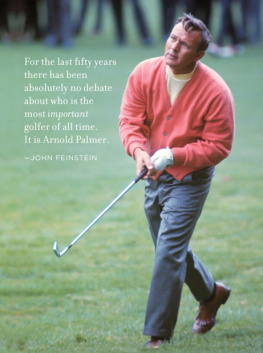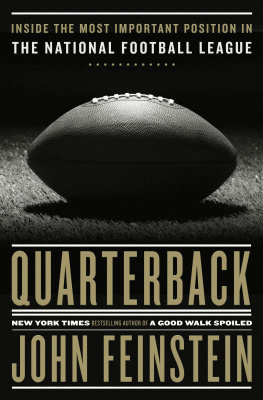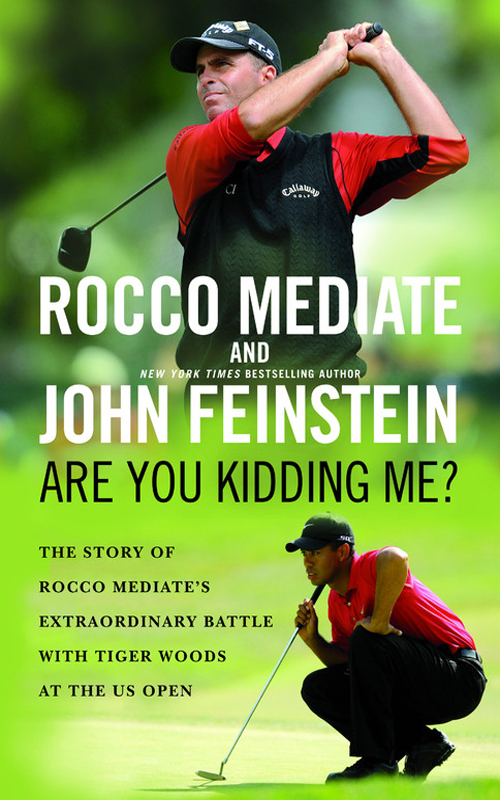Copyright 2009 by Imediate Balance and John Feinstein
All rights reserved. Except as permitted under the U.S. Copyright Act of 1976, no part of this publication may be reproduced, distributed, or transmitted in any form or by any means, or stored in a database or retrieval system, without the prior written permission of the publisher.
Little, Brown and Company
Hachette Book Group
237 Park Avenue, New York, NY 10017
Visit our website at www.HachetteBookGroup.com
www.twitter.com/littlebrown
First eBook Edition: May 2009
Little, Brown and Company is a division of Hachette Book Group, Inc.
The Little, Brown name and logo are trademarks of Hachette Book Group, Inc.
ISBN: 978-0-316-07374-5
ALSO BY JOHN FEINSTEIN
Living on the Black
Tales from Q School
Last Dance
Next Man Up
Let Me Tell You a Story
Caddy for Life
Open
The Punch
The Last Amateurs
The Majors
A March to Madness
A Civil War
A Good Walk Spoiled
Play Ball
Hard Courts
Forevers Team
A Season Inside
A Season on the Brink
Last Shot (A Final Four Mystery)
Vanishing Act: Mystery at the U.S. Open
Cover-up: Mystery at the Super Bowl
Running Mates (A Mystery)
Winter Games (A Mystery)
For my boys Rocco, Marco, and Nico
R.M.
For the Rules Guys: Mark Russell, John Brendle, Slugger White, and Steve Rintoul, who are always there day and night
J.F.
NEVER IN MY WILDEST DREAMS did I ever think Id be involved in a book like this one. Or any book, for that matter. Winning the United States Open, I could imagine. A book? No way.
But after my near miss at Torrey Pines in the Open last June, I started hearing from people that I should do a book, that I should tell my story not only about my duel with Tiger Woods, but about all that led up to it. Literary agents were coming at me with offers and writers, saying they knew just how to tell my story.
I was certainly intrigued, but also a little bit skeptical. Mine is not as you will learn a simple story. If it was going to be told, I wanted it told right. One writer showed me a proposal he had put together in which he had me talking to God during the Open playoff. I dont talk to God. I think He has enough on his plate without golfers asking him for an extra birdie or two. Maybe the guy got confused when he saw me talking to Tiger. A lot of people make that mistake.
So there I was in early July with these offers, and I still wasnt sure what to do. That was when Cindi Hilfman (who played a major role in my being able to accomplish what I accomplished at the Open) brought up John Feinstein.
Do you know him? she asked me.
Sure, I knew John. Id known him for years. Id always enjoyed talking to him, whether it was in the locker room or on the driving range, and I knew that Lee Janzen, probably my best friend on tour, had worked with him on a couple of his books and liked and trusted him.
Cindi, it turns out, is also a fan. Maybe its the whole Duke thing (she did her postgraduate work in physical therapy there), but she says shes read all twenty-three of his previous books. I havent. In fact, Im not sure if Ive read twenty-three books period.
Cindi suggested I call John to see if hed be interested in doing a book. Kelly Tilghman (another Dukie: I think theres a pattern here), who had done some work with me at the Golf Channel, had Johns contact information, so I tracked him down during, ironically enough, Tigers tournament at Congressional.
John asked me a lot of questions, one of which was if I was absolutely sure I wanted to do a book. I remember what he said to me: These things dont happen by magic. Its work. It will take time, and I may ask you some difficult questions. If you understand that and still want to do it, Im in.
To be honest, I dont think I completely understood what he was talking about. Now I do. It was a lot of work, but also a lot of fun. I thought there was a story to be told one that goes well beyond what happened during those five days at Torrey Pines and working with John, I came away even more convinced that was the case.
John made one other suggestion when we first talked: Lets not write this in the first person, he said. He thought that writing in the third person (I didnt even know what the hell writing in the third person was until he explained it to me) would give him more freedom to say things about me and tell the story in a kind of detailed way that first person doesnt allow.
Reading the book, I realized he was completely right. A lot of first-person athletes books (okay, I have read a few books) leave me wanting to know more, because the athlete doesnt want to tell you what he thinks about someone or about how difficult something was to achieve. John did a lot of reporting. He talked to all the key people in my life and to people I hadnt even thought about. In some cases, people told him things I didnt even know.
Dont worry, though, Im not going to pull a Charles Barkley and claim I was misquoted in a book my name is on. Ive read it carefully, and everything that comes out of my mouth in the book came out of my mouth when John had his tape recorder on.
I think its a pretty good story, one that Ive enjoyed living for the most part and one that I hope youll enjoy reading.
Overall, the experience was a fascinating one. I learned a lot about myself, my friends, and what goes into creating a book. I have only one regret: I heard a lot more about Coach K than I thought anyone could ever want to know.
I mean, the guy doesnt even play golf.
Oh, one more thing: The story John tells in the introduction about the title is true. Dont tell my kids.
Enjoy the book.
Rocco Mediate
IN THE 108 YEARS THAT the United States Open golf championship has existed, there has never been an Open like the one that took place at Torrey Pines Country Club in June of 2008. This was an Open so remarkable it even made the United States Golf Associations stubborn insistence on continuing to stage an 18-hole Monday playoff look smart.
The golf world has become accustomed to Tiger Woods doing things that no one else has ever done before. He won the Masters at the age of twenty-one by 12 shots. He won four major championships in a row. He changed his golf swing when he was the number one player in the world and got better. Then he changed it again and, after going 10 straight majors without a win, won five of the next 12. Midway through 2008, he had won 65 times on the PGA Tour 17 short of the all-time record and he was only thirty-two years old.
But his victory at Torrey Pines was spectacular even by his own spectacular standards. He had undergone knee surgery on April 15, two days after finishing second at the Masters and fifty-eight days before the start of the Open and hadnt walked a single 18-hole round of golf before he teed it up on day one of the Open. He was clearly still in pain throughout the tournament. Just finishing 18 holes, let alone 72 holes, would have been an accomplishment. To finish 72 holes tied for first place and then play 19 more the next day to win the championship was almost beyond belief.
I would have to say this is my greatest victory, he said when it was finally over.
And yet, extraordinary as it was, Woodss victory wasnt what made this Open unique. Had he won it in 72 holes by a shot or by two or three shots, it would have simply been another example of just how much better he is than every other golfer on the planet and would have set off another round of Tiger is the most dominant athlete in the world stories. All of which would have been correct and appropriate.




